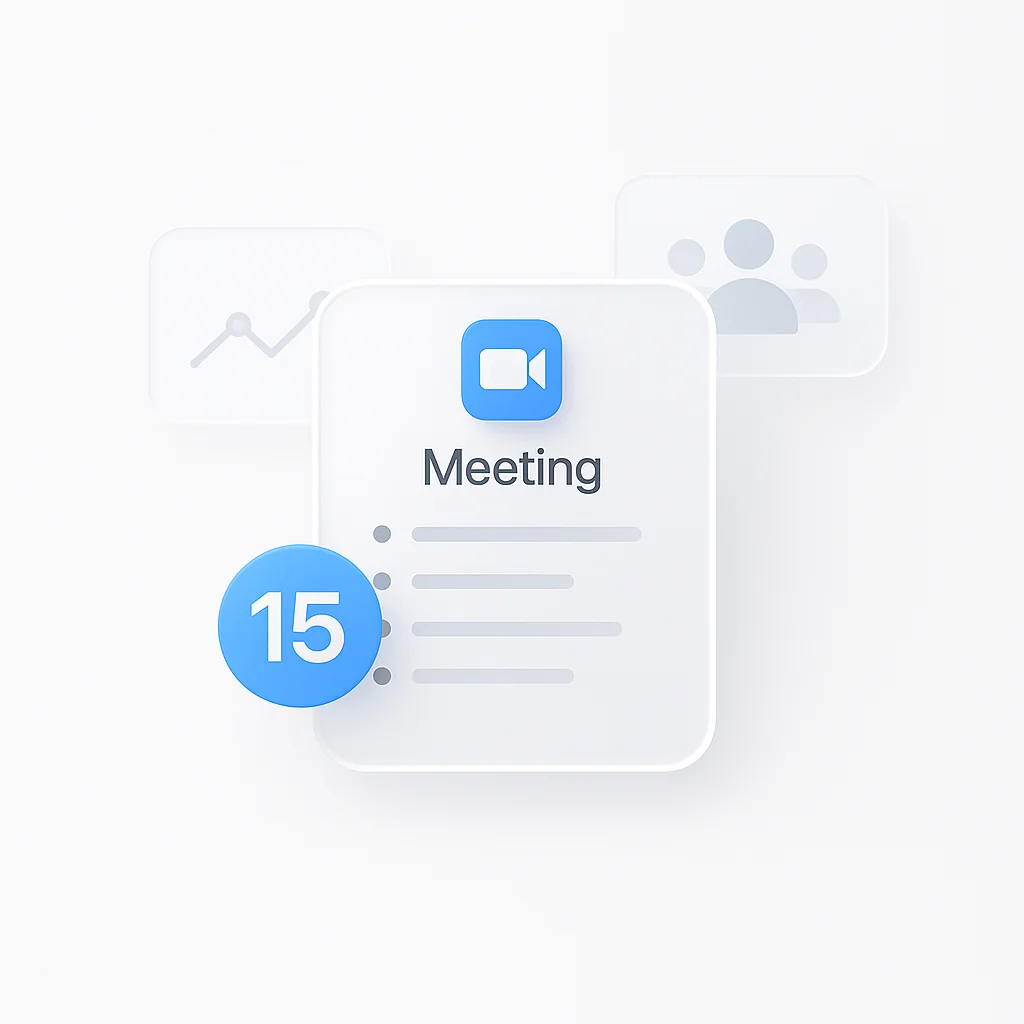How many hours have you spent in meetings that felt aimless, unproductive, or simply unnecessary? The root of the problem isn’t the meeting itself, it’s choosing the wrong type of meeting for the job.
This is your definitive guide to understanding the different types of meetings in business. We’ll explore the purpose behind everything from a daily stand-up to a formal board meeting, providing clear agendas and tips to ensure every meeting you schedule is purposeful, productive, and respectful of everyone’s time.
Why Choosing the Right Meeting Type Matters
The Benefits of a Purpose-Driven Meeting Strategy directly impact your bottom line. Companies that implement structured meeting frameworks save an average of 23% on meeting-related costs while increasing decision-making speed by 37%.
Saves Time - Money: Prevents inviting the wrong people or holding a one-hour meeting when a 15-minute check-in would suffice.
Increases Engagement: Attendees are more engaged when they understand the clear purpose and goal.
Improves Decision-Making: Ensures the right people and information are in the room for decision-making meetings.
Boosts Accountability: Clarifies goals and next steps for specific functions like project management.
When meetings have clear objectives and appropriate formats, teams complete 43% more action items compared to unstructured discussions. The key is matching your meeting format to your specific outcome.
Category 1: Informational Meetings (Top-Down Communication)
1. All-Hands Meeting / Town Hall
Purpose: Share major company-wide updates, strategic direction, and cultural initiatives
Best Practices:
- Schedule monthly or quarterly
- Keep presentations to 30-40 minutes with Q&A
- Use visual aids and record for remote employees
- Follow up with written summaries
Agenda Template:
- Company performance update (5 minutes)
- Strategic initiatives and goals (10 minutes)
- Team spotlights and achievements (10 minutes)
- Open Q&A session (15 minutes)
2. Departmental Meeting
Purpose: Cascade information to specific teams and align on department-level priorities
Best Practices:
- Hold bi-weekly or monthly
- Tailor content to team responsibilities
- Include department-specific metrics
- Encourage cross-functional updates
Agenda Template:
- Department goals and progress (10 minutes)
- Process updates and changes (10 minutes)
- Team announcements (5 minutes)
- Resource needs and support (10 minutes)
3. Information Sharing Meeting
Purpose: Present research findings, data analysis, or project updates with no immediate decision required
Best Practices:
- Distribute materials 24 hours in advance
- Focus on key insights and implications
- Allow time for clarifying questions
- Provide action items for follow-up
Recording these sessions ensures absent team members stay informed. Consider using a meeting recorder to capture every detail for later reference.

Category 2: Decision-Making Meetings (Driving Action)
4. Leadership / Management Meeting
Purpose: Make high-level strategic decisions that impact the organization
Best Practices:
- Limit to 6-8 key decision-makers
- Prepare decision briefs in advance
- Use structured decision-making frameworks
- Document decisions with rationale
Agenda Template:
- Review previous decisions and progress (5 minutes)
- Present new decisions needed (20 minutes)
- Discussion and debate (20 minutes)
- Final decisions and next steps (10 minutes)
5. Problem-Solving Meeting
Purpose: Tackle specific challenges through structured collaboration
Best Practices:
- Define the problem clearly before the meeting
- Include diverse perspectives and expertise
- Use problem-solving methodologies (5 Whys, Root Cause Analysis)
- Assign ownership for solutions
Framework:
- Problem statement and background (10 minutes)
- Brainstorm potential solutions (15 minutes)
- Evaluate and prioritize options (15 minutes)
- Assign action items and timelines (10 minutes)
6. Board Meetings
Purpose: Formal meetings for governance, major corporate decisions, and fiduciary oversight
Best Practices:
- Follow strict agendas and legal requirements
- Distribute board packets 48-72 hours in advance
- Keep detailed minutes for compliance
- Focus on strategic oversight, not operational details
These formal meetings often require precise documentation. A meeting summarizer can help capture key decisions and action items automatically.
Category 3: Innovation - Creative Meetings
7. Brainstorming Meetings
Purpose: Generate a high volume of new ideas without immediate evaluation
Best Practices:
- Set a “no judgment” rule during idea generation
- Use techniques like mind mapping or SCAMPER
- Aim for quantity over quality initially
- Record all ideas for later evaluation
Structure:
- Define the challenge or opportunity (5 minutes)
- Silent ideation phase (10 minutes)
- Rapid-fire sharing (20 minutes)
- Idea clustering and themes (15 minutes)
8. Innovation Meetings
Purpose: Develop and refine specific new concepts or initiatives
Best Practices:
- Include diverse skill sets and perspectives
- Use design thinking methodologies
- Create prototypes or mockups during the session
- Plan iterative development cycles
Process:
- Review market research and user needs (15 minutes)
- Ideate solutions collaboratively (25 minutes)
- Rapid prototyping session (30 minutes)
- Testing and feedback planning (10 minutes)
Category 4: Status - Alignment Meetings (Keeping on Track)
9. Daily Stand-up / Huddle
Purpose: Quick daily check-ins on progress, blockers, and daily priorities
Best Practices:
- Limit to 15 minutes maximum
- Use the three-question format (what did you do, what will you do, what’s blocking you)
- Stand to maintain energy and brevity
- Address blockers immediately after the meeting
10. Weekly Team Sync
Purpose: Align on weekly priorities, share updates, and coordinate efforts
Best Practices:
- Review previous week’s accomplishments
- Set priorities for the upcoming week
- Identify dependencies and coordination needs
- Keep to 30-45 minutes maximum
Agenda Template:
- Week in review (10 minutes)
- Upcoming priorities (15 minutes)
- Resource needs and blockers (10 minutes)
- Next week planning (10 minutes)
11. One-on-One Meetings
Purpose: Manager-employee check-ins for feedback, development, and support
Best Practices:
- Schedule regularly (weekly or bi-weekly)
- Let the employee drive the agenda
- Focus on development and career growth
- Document key discussion points
Framework:
- Personal and professional updates (10 minutes)
- Current project progress and challenges (15 minutes)
- Goal setting and development planning (15 minutes)
- Feedback and support needs (10 minutes)
For remote teams, using a video call room ensures seamless one-on-one conversations with automatic recording for follow-up.

Project Management Meeting Types
12. Project Kickoff Meeting
Purpose: Align stakeholders and define goals, scope, and expectations at project start
Best Practices:
- Include all key stakeholders and team members
- Clearly define project scope and deliverables
- Establish communication protocols and meeting cadence
- Document roles, responsibilities, and success criteria
Essential Elements:
- Project overview and objectives (15 minutes)
- Stakeholder introductions and roles (10 minutes)
- Timeline and milestone review (20 minutes)
- Risk assessment and mitigation planning (15 minutes)
13. Project Planning Meeting
Purpose: Detail timelines, resources, dependencies, and deliverables
Best Practices:
- Use project management tools for visual planning
- Break down work into manageable tasks
- Identify critical path and dependencies
- Assign clear ownership and deadlines
Agenda Structure:
- Work breakdown and task identification (30 minutes)
- Resource allocation and capacity planning (20 minutes)
- Timeline development and milestone setting (20 minutes)
- Risk and contingency planning (10 minutes)
14. Project Status Meeting / Check-in
Purpose: Regular updates on progress, issues, and adjustments
Best Practices:
- Use visual dashboards and progress indicators
- Focus on exceptions and blockers
- Make decisions quickly to keep projects moving
- Update stakeholders on timeline changes
15. Project Retrospective Meeting
Purpose: Analyze what went well and what could be improved after project completion
Best Practices:
- Create a safe environment for honest feedback
- Use structured retrospective formats (Start/Stop/Continue)
- Document lessons learned for future projects
- Celebrate successes and acknowledge challenges
Retrospective Framework:
- Project outcome review (10 minutes)
- What went well discussion (15 minutes)
- What could be improved analysis (15 minutes)
- Action items for future projects (10 minutes)
Using tools like transcribe meetings during project meetings ensures accurate documentation of decisions and action items.
How to Choose the Right Meeting Type: A Simple Framework
Before scheduling any meeting, ask these three critical questions:
1. What is the single most important outcome I need?
- A decision? → Use decision-making meetings
- Information sharing? → Use informational meetings
- Ideas generation? → Use brainstorming meetings
- Status updates? → Use alignment meetings
2. Who absolutely needs to be there to achieve that outcome?
- Decision-makers for approval meetings
- Subject matter experts for problem-solving
- Affected team members for informational sessions
- Creative contributors for innovation sessions
3. Could this be achieved without a real-time meeting?
- Email updates for simple information sharing
- Shared documents for collaborative input
- Asynchronous tools for status updates
- Video messages for one-way communication
Meeting Decision Flowchart
| Goal | Meeting Type | Duration | Frequency |
|---|---|---|---|
| Inform team | All-hands or departmental | 30-45 min | Monthly/Quarterly |
| Make decisions | Leadership or problem-solving | 45-60 min | As needed |
| Generate ideas | Brainstorming or innovation | 60-90 min | As needed |
| Track progress | Stand-up or status check | 15-30 min | Daily/Weekly |
| Plan projects | Kickoff or planning | 90-120 min | Project-based |
Formal - Specialized Meeting Types
Understanding Statutory and Formal Meetings
AGM (Annual General Meeting): Required legal meetings for shareholders to review company performance, elect directors, and approve major decisions. These follow strict regulatory requirements and must be properly documented.
Board Meetings: Formal governance meetings that require legal compliance, detailed minutes, and specific procedures under company law. Directors have fiduciary duties that must be fulfilled through proper meeting protocols.
Agile - Scrum Meeting Types
Modern software development teams rely on specific meeting formats:
- Sprint Planning: Define work for upcoming development cycles
- Daily Scrum: Brief daily synchronization for development teams
- Sprint Review: Demonstrate completed work to stakeholders
- Sprint Retrospective: Improve team processes and collaboration
For distributed agile teams, Microsoft Teams recording ensures remote participants can review sprint ceremonies they miss.
Meeting Best Practices Across All Types
Technology Integration: Modern meetings benefit from recording and transcription tools. A meeting library helps organize and search past discussions, while AI meeting assistants can capture action items automatically.
Preparation Standards:
- Send agendas 24-48 hours in advance
- Distribute required reading materials early
- Test technology before formal meetings
- Prepare backup plans for technical issues
Follow-up Protocols:
- Distribute meeting summaries within 24 hours
- Track action items with assigned owners and deadlines
- Schedule follow-up meetings for complex decisions
- Archive important decisions in searchable formats
FAQ
What are the 4 main types of meetings?
The four main categories are: Informational (sharing updates and data), Decision-Making (resolving issues and approving plans), Creative (brainstorming and innovation), and Alignment (status updates and coordination).
What is the difference between a meeting, a workshop, and a webinar?
Meetings are interactive discussions for specific outcomes. Workshops are hands-on learning sessions with skill development. Webinars are one-way presentations with limited audience interaction, typically for large groups.
How do you structure a meeting agenda for different meeting types?
Structure depends on purpose: Informational meetings start with key updates and end with Q&A. Decision meetings present options, discuss pros/cons, then decide. Creative meetings begin with problem definition, ideate freely, then organize ideas. Status meetings review progress, identify blockers, plan next steps.
What is the “three meeting theory”?
The three meeting theory suggests most business objectives require three interactions: Meeting 1 introduces the topic and gathers input, Meeting 2 discusses options and builds consensus, Meeting 3 makes final decisions and plans implementation.
What are the key meeting types in project management?
Essential project meetings include Kickoff (establish scope and team), Planning (detail timelines and resources), Status Reviews (track progress and address issues), and Retrospectives (capture lessons learned for improvement).
Meet with Purpose, Not by Default
By moving from default, unstructured meetings to purpose-driven formats, you can reclaim your team’s time, boost productivity, and make every conversation count. The key is consciously selecting the right meeting type for your specific goal.
Modern tools like ScreenApp’s video conferencing solutions and automated transcription services can help you implement these meeting types more effectively, ensuring nothing important gets lost in translation.
Remember: every meeting should have a clear purpose, the right participants, and a structured approach that respects everyone’s time. Choose wisely, and watch your team’s productivity soar.



